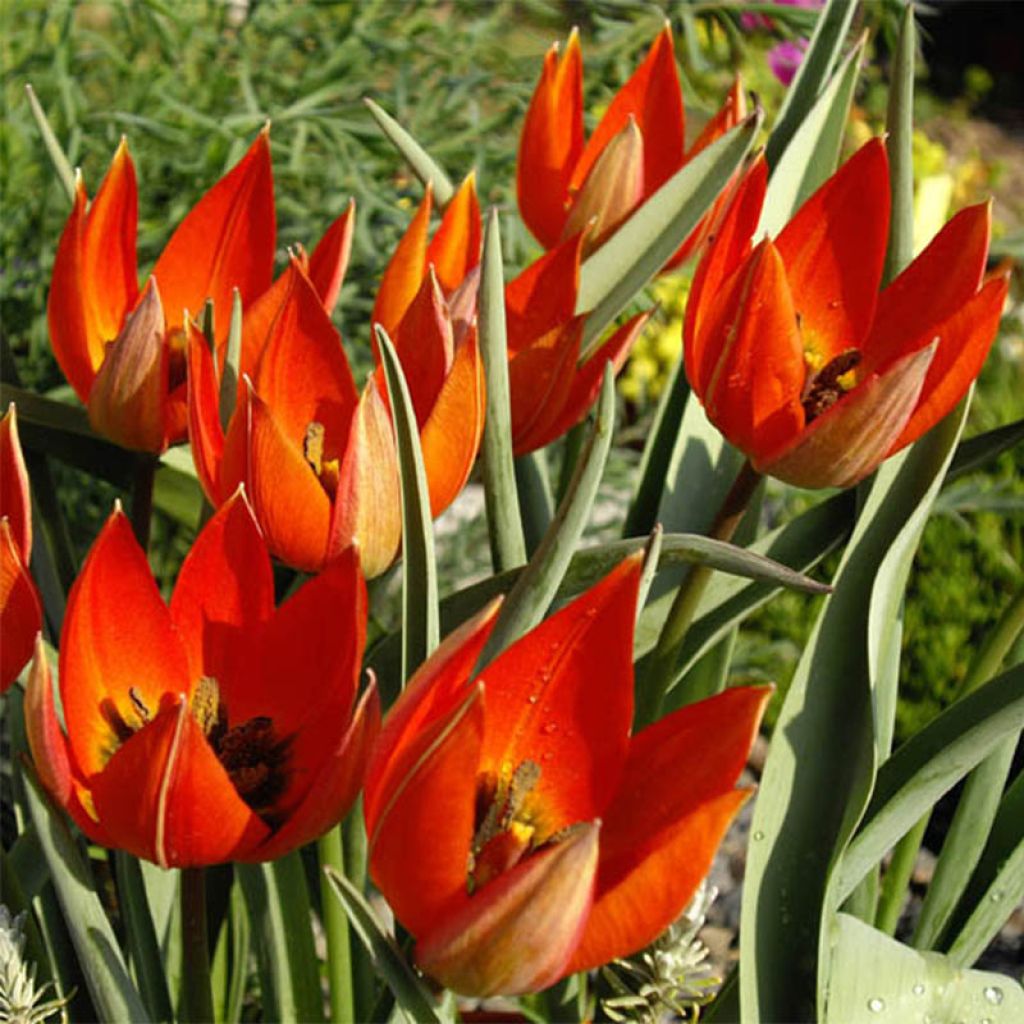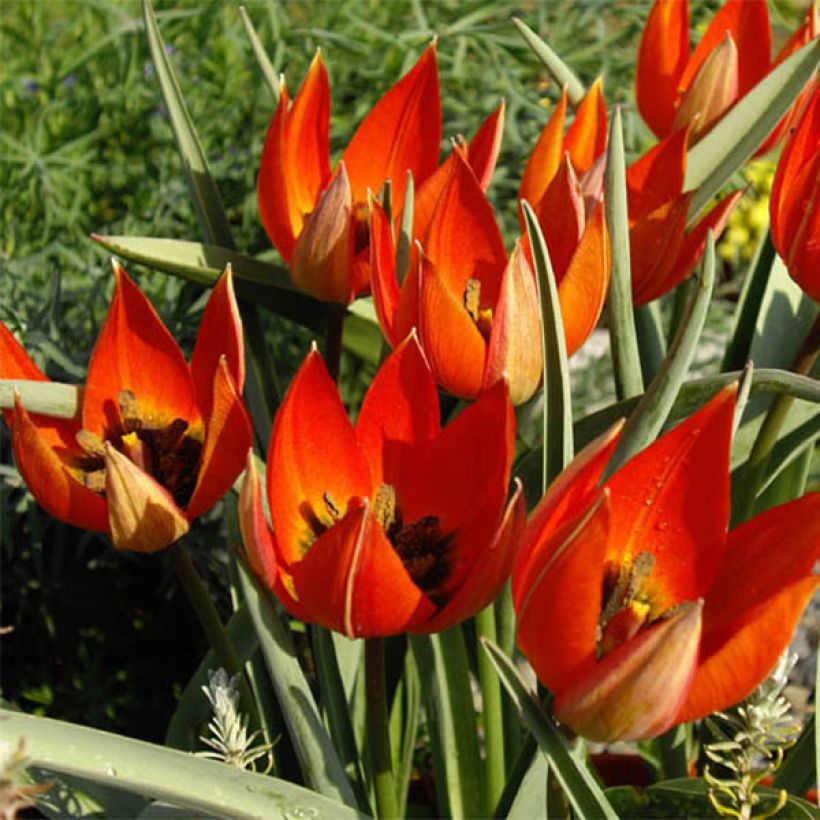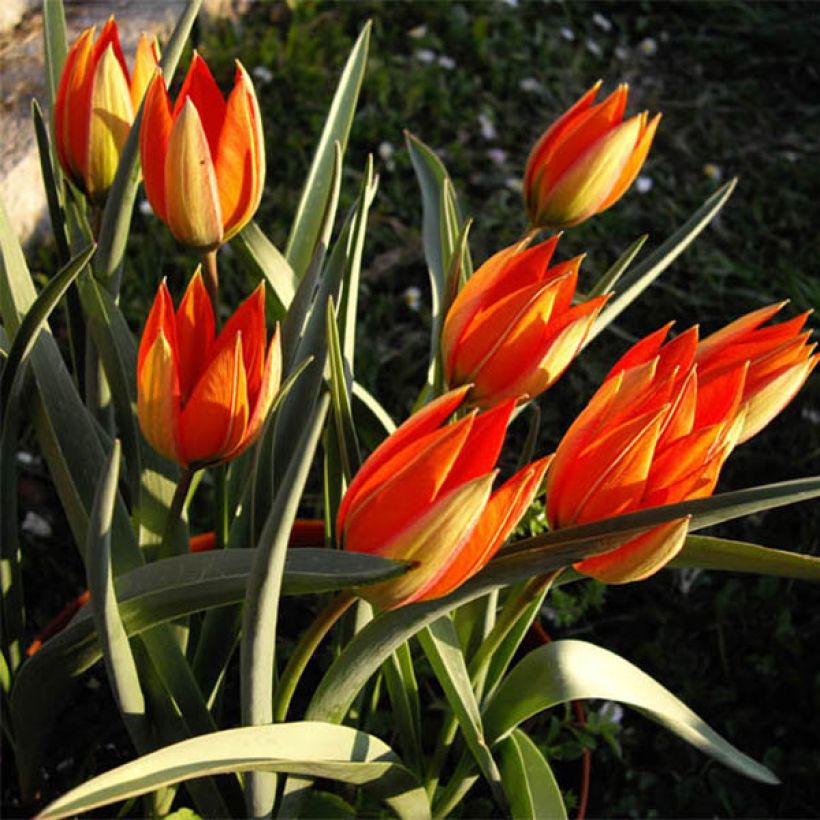

Tulipa botanique whittallii
Tulipa whittallii - Botanical Tulip
Tulipa whittallii
Tulip
Looking forward to the flowering.
Claudine W., 12/10/2018
This plant carries a 6 months recovery warranty
More information
We guarantee the quality of our plants for a full growing cycle, and will replace at our expense any plant that fails to recover under normal climatic and planting conditions.
From €5.90 for pickup delivery and €6.90 for home delivery
Express home delivery from €8.90.


Does this plant fit my garden?
Set up your Plantfit profile →
Description
Tulipa whittallii is a beautiful and delicate botanical tulip in coppery orange infused with blood orange, darker on the inside, and adorned with an olive green shadow at the base of its petals. An unusual and rare species, far removed from its Dutch cousins with their showy elegance and rigid habit. It proves easy to grow and long-lasting in the garden. It has perfect cup-shaped flowers in April-May, with lanceolate and tapering petals that let the light shine through, creating a flamboyant range of colours. This bulbous plant is a marvel when planted en masse in a lawn, a slightly wild bed, or in containers. It thrives in the sun, in well-drained, fertile soil.
Botanical Tulip whittallii belongs to the lily family. This "species" is a naturally occurring tetraploid clone* discovered near Izmir, in western Turkey. It is related to Tulipa orphanidea, and has quite variable appearances, with red, orange, or yellow-orange hues depending on the forms, climate, and soil it is grown in. This tulip will not exceed 30 cm (12in) high when in bloom. Its foliage is grey-green to blue, composed of 2 to 7 narrow, linear, pointed leaves. The 4 to 6 cm (2in) in diameter flowers are as elegant as the foliage and appear in April-May, earlier or later depending on the climate. Solitary or grouped in 2 or 3, they are borne by slender but sturdy stems that bend gracefully in the wind. They are oval and fused opening slightly at full bloom, forming a perfect calyx composed of pointed petals. The base of the petals and the heart of the flower are spotted with olive green, while the interior of the cup has an almost red hue, sometimes tinged with brown. The flowers bloom in the sun and close when it goes in. This tulip spreads through stolons and eventually forms beautiful colonies.
Botanical tulips do not degenerate over time like large-flowered tulips. They naturalise, can stay in place for several years without special care, and thrive in borders and rock gardens. To create colourful scenes, they can be planted with various small bulbs: Crocus, Muscari, Cyclamen coum, Snowdrops, Scillas... These tulips are unrivalled for bringing the colours of spring to pots or sunny gardens.
There are various wild species, many of which are endangered. In cultivation, these are called " botanical tulips", and one of the most common is the wild tulip (Tulipa sylvestris), which often used to grow sheltered by vineyards and whose subspecies australis is known as the southern tulip.
* Tetraploid: its basic chromosomal stock (2n) is multiplied by 2, so it is a "4n" plant.
Report an error about the product description
Tulipa whittallii - Botanical Tulip in pictures




Plant habit
Flowering
Foliage
Botanical data
Tulipa
whittallii
Liliaceae
Tulip
Cultivar or hybrid
Planting and care
Plant Tulipa whittallii bulbs in autumn, from September to December, at a depth of 10 cm (4in), 10 cm (4in) apart in regular, slightly acidic, neutral, or slightly alkaline, loose, well-worked, light, and well-draining soil. Botanical tulips like dry soils in summer and cold winters. Never add poorly decomposed manure or compost to the planting soil, as this could cause the bulbs to rot. Tulips grow well in moist to dry soil, in a good, sunny or semi-shaded location.
After flowering, their foliage becomes unsightly. We recommend planting Heuchera, Tiarella, Brunnera, Bleeding Heart or Euphorbia Cyparissia, in the foreground of your flower beds. Their foliage will enhance the colours of your tulips, and elegantly conceal their yellowed leaves.
Planting period
Intended location
Care
-
, onOrder confirmed
Reply from on Promesse de fleurs
Haven't found what you were looking for?
Hardiness is the lowest winter temperature a plant can endure without suffering serious damage or even dying. However, hardiness is affected by location (a sheltered area, such as a patio), protection (winter cover) and soil type (hardiness is improved by well-drained soil).

Photo Sharing Terms & Conditions
In order to encourage gardeners to interact and share their experiences, Promesse de fleurs offers various media enabling content to be uploaded onto its Site - in particular via the ‘Photo sharing’ module.
The User agrees to refrain from:
- Posting any content that is illegal, prejudicial, insulting, racist, inciteful to hatred, revisionist, contrary to public decency, that infringes on privacy or on the privacy rights of third parties, in particular the publicity rights of persons and goods, intellectual property rights, or the right to privacy.
- Submitting content on behalf of a third party;
- Impersonate the identity of a third party and/or publish any personal information about a third party;
In general, the User undertakes to refrain from any unethical behaviour.
All Content (in particular text, comments, files, images, photos, videos, creative works, etc.), which may be subject to property or intellectual property rights, image or other private rights, shall remain the property of the User, subject to the limited rights granted by the terms of the licence granted by Promesse de fleurs as stated below. Users are at liberty to publish or not to publish such Content on the Site, notably via the ‘Photo Sharing’ facility, and accept that this Content shall be made public and freely accessible, notably on the Internet.
Users further acknowledge, undertake to have ,and guarantee that they hold all necessary rights and permissions to publish such material on the Site, in particular with regard to the legislation in force pertaining to any privacy, property, intellectual property, image, or contractual rights, or rights of any other nature. By publishing such Content on the Site, Users acknowledge accepting full liability as publishers of the Content within the meaning of the law, and grant Promesse de fleurs, free of charge, an inclusive, worldwide licence for the said Content for the entire duration of its publication, including all reproduction, representation, up/downloading, displaying, performing, transmission, and storage rights.
Users also grant permission for their name to be linked to the Content and accept that this link may not always be made available.
By engaging in posting material, Users consent to their Content becoming automatically accessible on the Internet, in particular on other sites and/or blogs and/or web pages of the Promesse de fleurs site, including in particular social pages and the Promesse de fleurs catalogue.
Users may secure the removal of entrusted content free of charge by issuing a simple request via our contact form.
The flowering period indicated on our website applies to countries and regions located in USDA zone 8 (France, the United Kingdom, Ireland, the Netherlands, etc.)
It will vary according to where you live:
- In zones 9 to 10 (Italy, Spain, Greece, etc.), flowering will occur about 2 to 4 weeks earlier.
- In zones 6 to 7 (Germany, Poland, Slovenia, and lower mountainous regions), flowering will be delayed by 2 to 3 weeks.
- In zone 5 (Central Europe, Scandinavia), blooming will be delayed by 3 to 5 weeks.
In temperate climates, pruning of spring-flowering shrubs (forsythia, spireas, etc.) should be done just after flowering.
Pruning of summer-flowering shrubs (Indian Lilac, Perovskia, etc.) can be done in winter or spring.
In cold regions as well as with frost-sensitive plants, avoid pruning too early when severe frosts may still occur.
The planting period indicated on our website applies to countries and regions located in USDA zone 8 (France, United Kingdom, Ireland, Netherlands).
It will vary according to where you live:
- In Mediterranean zones (Marseille, Madrid, Milan, etc.), autumn and winter are the best planting periods.
- In continental zones (Strasbourg, Munich, Vienna, etc.), delay planting by 2 to 3 weeks in spring and bring it forward by 2 to 4 weeks in autumn.
- In mountainous regions (the Alps, Pyrenees, Carpathians, etc.), it is best to plant in late spring (May-June) or late summer (August-September).
The harvesting period indicated on our website applies to countries and regions in USDA zone 8 (France, England, Ireland, the Netherlands).
In colder areas (Scandinavia, Poland, Austria...) fruit and vegetable harvests are likely to be delayed by 3-4 weeks.
In warmer areas (Italy, Spain, Greece, etc.), harvesting will probably take place earlier, depending on weather conditions.
The sowing periods indicated on our website apply to countries and regions within USDA Zone 8 (France, UK, Ireland, Netherlands).
In colder areas (Scandinavia, Poland, Austria...), delay any outdoor sowing by 3-4 weeks, or sow under glass.
In warmer climes (Italy, Spain, Greece, etc.), bring outdoor sowing forward by a few weeks.


































